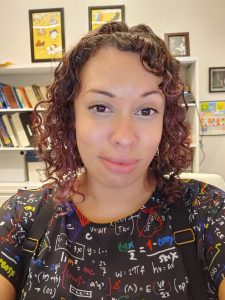**This post is a part of the series on the 2019 AGA Presidential Symposium – Sex and Asex: the genetics of complex life cycles**

About the author: Dr. Mercedes Burns is an assistant professor of biological sciences at the University of Maryland, Baltimore County. Her research focuses on the evolution of sexual reproduction and conflicts between the sexes, particularly in invertebrate animals. Follow Mercedes on Twitter @DrCedes and via her lab’s website.
The idea for the research in this paper was conceived nearly 10 years ago.
As a graduate student, I was studying North American Opiliones when I came across a mention of two Japanese species with similar morphological adaptations to antagonistic mating that I was seeing in my own backyard in Maryland. Intrigued, I managed to persuade Dr. Prashant Sharma (then a postdoc at the AMNH, now faculty at the University of Wisconsin, Madison) to grant me a speaking slot at the International Society for Arachnology in Kenting, Taiwan. I was able to introduce myself to Dr. Nobuo Tsurusaki, coauthor on the work that piqued my interest. At that meeting, we hatched a plan. During my population genetics course, I began writing the proposal that would eventually be funded by a National Science Foundation Postdoctoral Fellowship in Biology.
The road to publishing this paper was long for three reasons:
- Molecular research projects can be pricey, especially for an independent postdoc on a taxable personal budget! I had to learn a number of new genotyping approaches to decide which would ultimately work here, and the learning curve was steep for me.
- Second, two years of specimen collection were ultimately necessary to compare northern and southern populations. None of the northern specimens I collected in 2015 produced eggs! That collecting trip was not a loss, though-I recall a particularly memorable moment in a park in Aomori Prefecture where Dr. Tsurusaki and I caught a mimizemi, a native cicada whose call evokes the quintessential Japanese summer day. As we released the jewel-like insect, a bird swooped down, caught it, and furiously hammered it to a tree!
- Third and lastly, this paper was a long time coming because I began molecular work at probably the most precarious part of my postdoc-the VERY end! I was busy applying for faculty positions and worrying over whether I would find a job by the time my funding ran out. As in all things, perseverance led to a satisfying payoff.
I can now share in the successful publication of this work with my lab’s first Ph.D. candidate, Tyler Brown. The paper’s acceptance arrived prior to my Japanese mentor’s retirement after decades of observation of Japan’s unique and fascinating arthropods. I am pleased also to share this work with the readers of the Journal of Heredity, as I’d always hoped to do.



